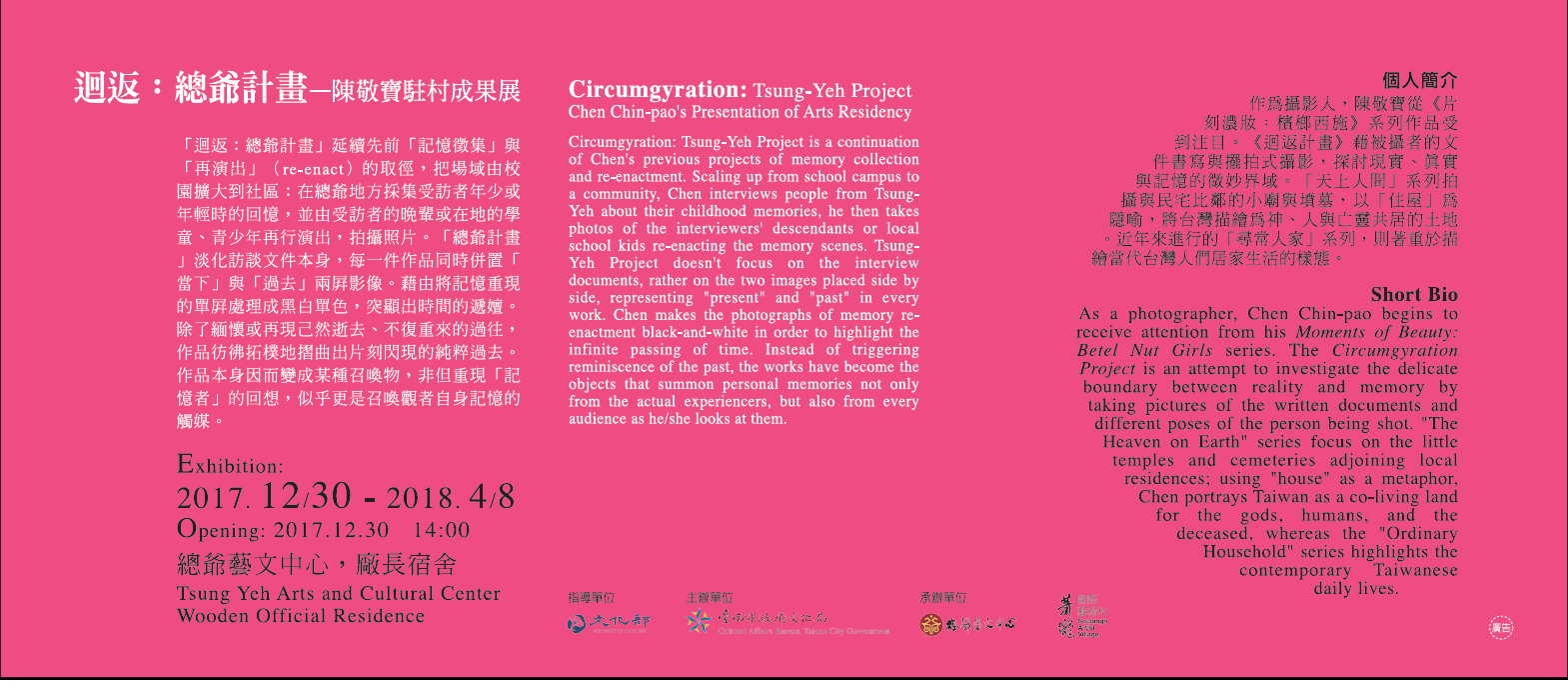

展覽介紹|
藝術家陳敬寶於總爺駐村期間,透過與周邊居民訪談後,採集受訪者年少回憶,再由其晚輩或在地學童、青少年進行演出拍攝,每件作品皆呈現「當下」與「過去」兩屏影像,期待能成為召喚觀者自身記憶的觸媒。
展覽資訊|
迴返:總爺計畫 – 陳敬寶駐村成果展
展期Duration|2017.12.30~2018.04.08
地點Venue|南瀛總爺藝文中心Tsung-Yeh Arts and Cultural Center
開幕暨記者會Opening|2017.12.30 14:00


展覽介紹|
藝術家陳敬寶於總爺駐村期間,透過與周邊居民訪談後,採集受訪者年少回憶,再由其晚輩或在地學童、青少年進行演出拍攝,每件作品皆呈現「當下」與「過去」兩屏影像,期待能成為召喚觀者自身記憶的觸媒。
展覽資訊|
迴返:總爺計畫 – 陳敬寶駐村成果展
展期Duration|2017.12.30~2018.04.08
地點Venue|南瀛總爺藝文中心Tsung-Yeh Arts and Cultural Center
開幕暨記者會Opening|2017.12.30 14:00

展覽介紹|
「賴純純:仙境」個展,旨在鋪陳公元2000年以來,賴純純多元發展的藝術路線和豐碩迷人的創作成果。「仙境」做為賴純純近年創作的核心主題,溯自千禧年的元旦清晨,她和眾人聚立在臺東的海岸邊,興奮地注視著新世紀照入臺灣的第一道陽光,當場竟感受到了—不論是個人之自我完整性的實現,或對這塊生長土地之存在處境的體認,似乎大家都活在一種明暗交混、真假難辨的虛幻和迷惘之中!個體生命的「自由」價值,是賴純純創作背後的終極信仰,而「仙境」不同系列創作的從此開展,則是賴純純希望透過個人的意志、創意的想像、生命力的表達與溝通,從現實中重新建構自我的神話,創造新時代之象徵和寓意的一個永續的藝術與文化工程。
展覽資訊|
「賴純純:仙境」個展
展期Duration|2017.10.28~2018.01.21
策展人Curator|石瑞仁
地點Venue|國立台灣美術館 National Taiwan Museum of Fine Arts

【日常建構】創作聯展,自2017年11月14日至2018年1月15日,於王道銀行藝廊展出。此次展覽由五位畢業於國立台中教育大學美術系、新竹教育大學美術系以及國立台灣師範大學美術系的藝術家參展,共計展出20件作品。展覽以「日常建構」為名,主張差異使人獨特,強調即使在相同的文化與時空背景之下生長,即便擁有相同的共識或生活習慣,但心靈深處的淺層意識卻是獨一無二的,展覽以五位藝術家在日常生活中所累積的種種日常建構,揭示了五種不同思考的角度與態度。
本次展覽中,周芳年以油性顏料和水墨為主要創作媒材,以個人潛意識為主題進行創作;陳胤蓉以生活中的現實場景作為創作主軸,透過作品闡述對人生的態度與想法;石志偉則以「花」與「紙鶴」作為創作題材,認為花開花謝就像是人生的縮影,而紙鶴的靈感則來自小時候摺紙鶴的經驗;顏群則以「毛巾」貫穿整個作品,將毛巾擬人化的方式進行敘事,並以劇場式的構圖呈現;梁育瑄利用粉彩勾勒水珠樣貌的流動感,強調生命中的瞬間,都因為接收方式的差異而有著萬千的面貌。
五位藝術家的作品媒材與主題雖迥異,但共同的初衷卻不變,期盼觀者在每一幅作品前駐足,深刻體會作者隱藏作品其中的點滴趣味。
展期Duration|2017.11.17~2018.1.15
地點Venue|王道銀行藝廊(台北市內湖區堤頂大道二段99號)
開幕Opening|2017.11.17 (五) 18:00 – 19:00
https://www.o-bankef.org/

「人艱不拆」為網路用語,出自林宥嘉《說謊》一曲,原句為「人生已經如此的艱難,有些事情就不要拆穿」。本展由生活處境/生存方式、日常/非日常兩組對立的姿態切入,輔以面對網路世界時獨白/對話、虛擬/真實兩組對照,以作品為認識與辨識過程的起點與終點,探討數位技術中的諸多身體經驗。
人們因受到媒體養成,在觀看與思考現實世界的人事物時,會出現一種與數位媒體近似的運算邏輯;八位參展藝術家以近乎反數位,卻又回應數位技術的身體經驗,指出人們思考邏輯被「數位化」,進而遺忘觀看方式其實依然傳統的狀態。參與「人艱不拆」展覽的藝術家,在拆與不拆之間,以看似再現媒體技術的姿態,罷黜了再現的可能,卻因此獲得了更多關於「再現」本身更多的感知機制。
在數位技術產生之前,數位經驗早已被建構,並成為被理解的對象,換言之,數位經驗一直以來都包含著類比式的理解邏輯,「人艱不拆」一詞包含一種,用類比經驗理解數位感受的難分難捨,以及數位經驗停留在類比知識所無法理解的狀態。本展藝術家的作品,展示了生活與生存情境下的經驗與知識,如何在數位與類比之間重覆斷裂又重新銜接。風、聲、光、電、圖像與影像的線索中,讓身體速率在同步的基礎上,得以開啓原初的感受。
展期Duration|2017.11.25~2018.01.28
策展人Curator|陳漢聲、劉星佑
地點Venue|台中市西區五權西路一段2號
https://event.culture.tw/NTMOFA/portal/Registration/C0103MAction?useLanguage=tw&actId=70170

展覽介紹|
「向空中突襲,描繪前景。」這是京都出身的梅原龍三郎在 1940 年 9 月 2 日《北京日記》的一句畫家心語。梅原在《長安街》這幅畫完成後,準備用北京飯店鳥瞰的視角,描繪北京紫禁城,這個角度,與台南畫家郭柏川從北側景山的角度鳥瞰紫禁城,各有異趣。但是,到了 1942 年的《北京之秋》這幅畫中,梅原的視角卻從北京飯店五樓西側的房間開窗,向上抬昇,轉向秋天肅殺的天空,空景漸漸成了畫面的主題。到了 1943 年的《北京之窗》,紫禁城城樓在綠蔭中的比例更小了,岩繪與膠彩的色彩平衡技法,如今加上邊緣外推的窗框,強化了畫框的物質存在感,也反指出鳥瞰視野本身的框限。這幅畫不僅補註繪畫現代性的自我指涉,也透過空景與窗景,突顯更多的天空本身之空。
這個展覽從這個「向空中突襲」的「空中之空」出發,將現當代藝術視為一個物質性的「空的場所」,這種不純粹的空,具有三種無可迴避的特質:首先突襲的是現代藝術史中,繪畫本身的歷史與物質條件如畫框、帆布、視線佈置等的無可迴避;其次,這個突襲也意味著二戰中與二戰後台日之間、以及台日與中國之間,帝國、戰爭、殖民、文化間競合因素的無可迴避;最後,突襲也指向台灣當代藝術的自我鳥瞰,呈現充滿複雜視線的天空,以及從日本、沖繩到越南的對話脈絡中,這種自我鳥瞰的多樣性。
「向空中突襲」納入了梅原龍三郎、小出楢重、里見勝藏三位日本現代畫家的畫作,分別呈現了繪畫現代性的風景與自我指涉、蓬萊山景的漢學因子,以及歐洲山城景觀的色彩與空氣;四位台灣藝術家的作品,則包含高俊宏結合過去文獻與長期踏查發展的新作《大豹.台灣實況紹介》、陳伯義以台灣中國城與紅毛港為拍攝對象的「窗景」系列,莊宗勳挪用故宮所藏清明上河圖並重新賦予當代元素的《清明上河園區.今日公休》,以及林玉婷近期關注台灣鐵路沿線景觀而發展的「蛋糕」系列等。他們分別透過錄像、裝置、攝影、長卷、繪畫等形式,去對應三位日本現代畫家眼中的「風景」,突顯當中日本、中國、歐洲與在地/離散族群生命之間的異質性。此種異質性,總是在建築樣式與地景形式中留下痕跡,本展所謂的異質風景,意旨即此。最後,透過越南藝術家裴公慶的繪畫與裝置,以及沖繩藝術家阪田清子的物質結晶,觀者得以看見,同樣的鳥瞰,卻有不同的視野,在台日之間,尚存有無以數計的變樣風景。
有中之有,空中之空,鏡花水月,以至無限。藉由這個展覽的鳥瞰,我們希望為觀眾打開一扇關於台日現當代藝術的異質風景之窗。
展覽資訊|
向空中突襲:台日現當代異質風景的藝術鳥瞰 – 裴公慶、陳伯義、莊宗勳、高俊宏、小出猷重、林玉婷、里見勝藏、阪田清子、梅原龍三郎
展期Duration|2017.10.18~2018.01.13
開幕Opening|2017.10.18 (18:30–20:00)
地點Venue|台北日動畫廊 galerie nichido Taipei

展覽介紹|
活躍於紐約、台北、雲南大理三地的當代藝術家韓湘寧,將於106年12月3日至107年2月11日,在台北「有璽藝術空間」展出作品。韓湘寧早期參加60年代「五月畫會」,投入藝術已將近一甲子,一直保有獨樹一幟的鮮明風格。1967年移居紐約後發展「極淡系列」,以極淡彩點用噴槍微噴於畫布。
由於在創作中表達主觀印象,迴異於當時所盛行的極客觀的「照相寫實」,因此逐漸被歸列為「非典型照相寫實」。 1976年,韓老師被選入美國建國二百年移民藝術家特展,與建築師貝聿銘為其中僅有的兩位華裔藝術家,2011年他在雲南大理才村將原來的工作室改建為「而居當代美術館」。
這次在有璽藝術空間的「韓湘寧 穿越時空」1969-2017 台北‧大理.紐約展,包括一幅創作於1969年紐約的「隱現 零點五秒」,即為極簡極淡作品,其他的作品有2015年開始在大理、紐約、台北創作的「雨水非水墨」;以魚池、街道人孔蓋上雨後積水所反映的「雨水自畫像」,還有取材於紐約蘇活區,光影、色彩皆美的建築影像後製等作品。
展覽資訊|
穿越時空 – 韓湘寧
展期Duration|2017.12.3-2018.2.11
策展人Curator|
地點Venue|有壐藝術空間 YX Art Space
開幕暨記者會Opening|2017.12.3

富邦藝術基金會自1997年成立以來,秉持「分享」的初衷,以贊助推廣藝術,落實藝術教育,提昇文化品質為創立宗旨。藝術基金會透過各種文化藝術的講座、展覽、表演、活動、研討、學術研究及出版等,將文化、思想、美學上的品味與新視野傳達給社會大眾,並且獎勵培植有潛力的年輕藝術人才,進而推動國際藝術文化的交流。
在開辦業務的精神上也堅守深遠的影響為目標,長期舉辦台北東區當代藝術展「粉樂町」、生活美感充電站「富邦講堂」,創立東區生活刊物「媒婆報」、合作企劃廣播節目「藝術好好玩」等都具有一定的影響力,2015年更創新與關係企業富邦旅管,進行藝術生活的實踐,將無牆美術館、藝術家進駐計畫、文創選品店等忠實呈現,成為都市更新的全新範例,未來更將以全新的藝術教育與營造藝術環境自許,提供大眾更多樣化接觸美的機會,建立數位藝術平台,落實真正的交流與資源共享,並肩負起讓世界看見台灣的使命。
2017年為富邦藝術基金會的20周年,在藝術基金會位於仁愛路上的「藝術客廳」(Living Art Space) 空間內,展出20年來致力於「藝術生活化,生活藝術化」的推行成果,包括富邦講堂、媒婆報、無牆藝術展與藝術商品設計等業務的精采內容,以及七位曾在過去參與粉樂町展覽的當代藝術家──林建榮、阿咧先生、黃法誠、黃冠鈞、黃美惠、黃蘭雅、蔡潔莘──作品重現與再詮釋;更首次開放藝術行政資料庫供觀者閱覽,是有志於藝文教育推動者,或想一窺行內究竟,深度瞭解富邦藝術基金會的民眾,不可錯過的絕佳機會。
展期Duration|2017.11.01~2018.4.28
策展人Curator|林建榮、阿咧先生、黃法誠、黃冠鈞、黃美惠、黃蘭雅、蔡潔莘
地點Venue|台北市大安區仁愛路四段258號2樓
https://www.facebook.com/fubonart/

展覽介紹|
亦安畫廊台北將舉辦黃海欣、林亦軒兩位旅居美洲的台灣藝術家個展。分別以紐約、拉丁美洲為生活與創作的據點,在這兩位80後藝術家的豐富創作能量中,能明顯看見他們的生活與想法,藝術與他們的濃稠連結,最終如何把所見所感、生活起落轉化為與幽默、解放的反覆主題。
黃海欣自 2010 年起在當代繪畫界發揮了開創性的角色。作為一名畫家,黃海欣由各式各樣高級與流行文化中尋找主題、真實與諷刺,完成無論於內容上、圖像上、技法上皆顯緊湊的複合體。在她的繪畫中-尤其 2013 年底開始發展的〈博物館〉、〈桑拿〉、〈江南〉等系列,黃海欣從消費者、觀光客的世界與「高度文化」中吸取各種元素,然後宛如生活與廣告間的微妙關係,她也引用藝術與消費間的依賴與矛盾,她並且成為這種表現的無比高手,在崇高與平淡之間相互作用,再現這些場域裡的熟悉主題,最終在一種淡然狀態下描述了媚俗與諷刺。黃海欣帶有尷尬的繪畫風格豐富地表現她於各國遊歷時所看到的場景:有時看起來很脆弱,有時看起來很興奮-迷人和挑釁是顯而易見的並存。
「我主要繪製我所見證的荒謬,而存在繪畫中的某種尷尬來自我作為外國人的令人沮喪的生活經歷-很多時候,事情並沒有如我預期地那樣奏效,從線上客服到約會體驗等,沒有什麼是浪漫的和理想的。在這樣的經驗裡,幽默感是我生存的最重要力量。生命充滿繁瑣與失調,但是我正試圖向觀眾展示稍縱即逝的不可思議的美麗:我們的幽默以及悲劇、人生的宏偉以及人性的脆弱。」黃海欣說道。
林亦軒的紙上作品綜合了多種技法與顏料,藉此提供同時既是不斷變化的抽象,同時又是比喻與敘述的圖像世界-就像「現實」往往是我們想像以上更廣泛、更全面、且更不真實一樣-他試圖描繪且呈現一種恆定、卻又經常混亂的狀態。這些 2013 至 2014 年製作的作品,是林亦軒初到拉丁美洲時期所做,或許就與南美及台灣的多元文化一樣,他在創作這些作品時,受到地點文化轉換所經歷的所有現象的多重關聯、形式、感受啟發,促使他在作品中創造令人驚奇的組合與脫序,包含且壓縮大量看似無關的符號,重疊多種畫風與風格。林亦軒不斷在形象、抽象、描繪和重複性模式之間轉變,同時他深受美國垮掉一代凱魯亞克 (Jack Kerouac)的影響:貧困、潦倒、一無所有、流浪,探索哲學與神秘主義的解放,最後似乎表達了人類感知和經驗的所有豐富,但最終卻又不可知的各種東西。
「我知道垮掉一代是2011年在阿根廷時有朋友跟我提起,之後我便一直收集他們的資料。雖然我在拉美遊蕩一開始不是受他們影響,但這幾年我對他們團體的氣氛和作家的創作方式一直很有興趣,我的作品裡的『不穩定』物件(例如旗子、雞蛋、草、水等等)也多少受了他們文學作品的影響。 當我思考如何點出拉美特質、或含括我這三年生活和創作的起落時,我便想到這段期間,他們的作品是我倚賴的精神糧食,所以決定取自他們作品裡的話來當作展名-雖然他們來拉美都是來找迷幻藥。」林亦軒自述道。
展覽資訊|
展期Duration|2017. 11. 24 ~ 12. 30
策展人Curator|黃海欣Huang Hai-Hsin 林亦軒Lin Yi-Hsuan
地點Venue|亦安畫廊台北 aura gallery Taipei
開幕暨記者會Opening|2017. 11. 24 (Fri.) 6 p.m.( 藝術家將出席酒會 )
座談活動Talk|2017. 11. 24 (Fri.) 6 p.m.

展覽介紹|
Conceptual art is made to engage the mind of the viewer rather than his eye or emotions. Conceptual art doesn’t really have much to do with mathematics, philosophy, or any other mental discipline. – Artforum (June, 1967).
「世界客觀性如何能被主觀地認識?」- 埃德蒙德·胡塞爾(Edmund Husserl)
從具時代代表性的普遍科技工具google翻譯產出的錯誤文本,展開了飄忽、瀟灑、斷裂的資訊閱讀感。畫面裡再平凡、簡單不過,來自於網路世界圖庫的影像,交錯互相成為彼此畫面裡的真實,成為虛幻與現實難分的平面時間雕塑。
身處資訊便利、快速、且無限般大量的網路資訊時代,我們該如何面對在資訊經驗、記憶和想像裡,不斷快速擴張當下社會?而我們如何隨著影像、資訊的被大量製造的同時,也組織了由想像建造的「新世界觀」?
雖保留部分原型、但卻扭曲的姿態單獨呈現的「訊息雕塑」,藍幕、網路資訊圖像混雜、拼貼而成的訊息軟雕塑體,資訊影像實體與藍色布幕間的幽微作用,成了莊培鑫作品最詩意的記憶點。
莊培鑫2017年個展中的作品,把一幕幕看似平凡的山、林木景致變成屏幕,建構出一座想像與精神交疊的感官劇場,彷彿讓一組組「虛擬、重疊且分裂」的影像找到了浪漫的替身,並嘗試追問,究竟「敘述現實」與「製造虛構」,哪一個比較容易?
藝術家對資訊經驗、記憶的爬梳與挖掘,爾後轉化嘗試闡述,察覺意識與特定事物之間的幽微作用。藝術家的創作與思想提醒了我們,我們所能認為的地理、或物理性的世界,可能還包含了人的意識與經驗所投射、甚至反映的精神世界。
潛藏在這次個展中,google翻譯便象徵著一個來自科技社會的尚未完善、功能失準的存在。這一個個失誤背後所創造的雖便利但不舒適,甚至造成生活的異化的是,是那看似悠然唯美的文字俳句,直到有一天它被完善地改良,他才會消失。面對躁亂的時代資訊經驗,藝術家以本次個展的創作作為執行,選擇不順從歷史的脈絡,去嘗試組織、勾勒出另一種認知與敘述現實的渠道。「如果在適當的條件下」是一檔關於重新思索資訊時代與想像世界觀的展覽。
一共三部缺乏故事、世界觀、與主角的劇場,透過創作者將資訊主觀地拼貼,弔詭但卻浪漫地映演了、回應了這個時代的人們,是如何面對訊息、解讀和想像。而令觀者面對畫面中文本時所獲得的真空感,來自於作品冷調和幽然所製造的混亂與心慌。我們所面對的所有科技與資訊,一切可能皆可能被破碎解讀、一切可能皆屬偶然。
_________________________________
參考資料
” Paragraphs on Conceptual Art ” – Sol Lewitt /Artforum (June, 1967).
Thinking on Screen: Film as Philosophy – By Thomas E. Wartenberg
「生活世界的本體論」與「實踐的一元論」- 張慶熊,復旦大學哲學學院教授、博士生導師,復旦大學國外馬克思主義研究中心副主任、研究員。
《歐洲科學危機與超驗現象學》- 埃德蒙德·胡塞爾
初探 Sophie Calle 與佛洛伊德說的《真實故事》-議藝份子 第十四期
展覽資訊|
展期Duration|2017.11.11~12.24
策展人Curator|莊培鑫Pei-xin Chuang
地點Venue|紅野畫廊Powen Gallery
開幕暨記者會Opening|2017.11.11 15:30
座談活動Talk|2017. 12. 24 10:00~19:00

展覽介紹|
2009年2月,藝術家侯淑姿因投入高雄左營的眷村調查研究而進入了高雄眷村,也走入了眷村居民的生命歷程。八年多來,她以天職般的使命感介入眷村文化保存的工作,產生了與眷村居民休戚與共的患難情感。在高雄眷村,侯淑姿與地方空間相遇,與不同生命的歷程交織,開創了一種跨越紀實攝影、田野敘事、社會性實踐的多重界限的藝術。
In February 2009, artist Lulu Shur-tzy Hou visited military dependents’ villages in Kaohsiung as part of a survey research on the city’s Zuoying Military Dependents’ Villages, which brought her into contact with the lives of military dependents’ village residents. Throughout more than eight years, she has been driven by a deep sense of mission to involve herself in the effort to preserve the culture of military dependents’ villages, and as a result has personally shared the trials and tribulations experienced by village residents. In Kaohsiung’s military dependents’ villages, Hou’s encounters with local spaces and her life interwoven with different courses of life have inspired her to develop a style of multi-domain art encompassing and transcending documentary photography, field narratives, and social practice.
本展為策展人黃孫權與藝術家侯淑姿繼2010年高美館的創作論壇《望向彼方:亞洲新娘之歌》後再次合作。此高雄眷村三部曲是為藝術家多年深入高雄左營與鳳山眷村創作的總結。藉由策展人稱之為「雙眸」風格的正負影像並置、主客觀點並陳的表現手法,作品呈現了在眷改條例下幾經波折動盪的離散滄桑,以及藝術家與眷村居民在對話中所交疊的當代史心聲。
This exhibition represents a further collaborative effort involving curator Huang Sun Quan and the artist in the wake of the “Look toward the Other Side: Song of Asian Foreign Brides in Taiwan,” which was held in 2010 under the auspices of Forum for Creativity in Art at Kaohsiung Museum of Fine Arts. A Trilogy on Kaohsiung Military Dependents’ Villages summarizes the artist’s creative work involving Kaohsiung’s Zuoying and Fengshan military dependents’ villages over the course of many years. Employing the juxtaposition of positive and negative image pairs — which is termed a “Double-gaze” style by the curator, the artist superimposes subjective and objective viewpoints. Her work displays the dispersion and disruption of the military dependents’ villages, the turmoil and transience of the village residents’ lives as well as their appeals for “going back home” due to the improper execution of “Act for Rebuilding Old Quarters for Military Dependents,” and creates a contemporary epic of local history interwoven with the artist’s narratives and her dialogue with the residents.
自2013年的《我們在此相遇》、2015年《長日將盡》,到新近完成的《鄉關何處》系列,此三部曲系列作品映照出眷村的不同命運—人物全非的、房舍依舊但人回不去的、仍奮力存活的家園。藝術家透過攝影記錄、訪談調查、行動介入,在社會性空間裡生產藝術;於田野間、於藝術家以身為度之際、於居民向公共歷史說話中生產作品。
The trilogy, which consists of the “Here is where we meet” series published in 2013, the “Remains of the Day” series published in 2015 and the recently-completed “Out of Place” series, reflects different fates of military dependents’ villages: people and houses all gone, houses still present but no people living in them, and still-thriving communities. The artist relies on her photographic record, interviews, and active intervention to produce art in social spaces. In the field, the artist has deep empathy with the residents. Going together, they create a public history and start a conversation with Taiwan’s societies.
藝術家的攝影並非再現眷村,而是創造我們與眷村的共感,讓鮮少被論及的眷村女性得以顯露其生命歷程,並揭示出全台消亡的眷村乃公共住宅私有化的歷史。長期致力於從女性觀點書寫與創作的侯淑姿,令我們聆聽眷村女性的聲音,看到她們與國家、家園、男性愛恨糾纏的容顏。同時令我們意識到眷村不是鄉愁,而是一段讓台灣社會聚落失去一切共有 ( 家園、記憶、共同生活 ) 的殘酷歷史的一部分。也因此,此展覽能夠使得我們從「應當去那兒住」( there that I should like to live )的感受性—巴特認為攝影最好的品質—出發,思考逼問台灣土地上每一個人的、而非僅是眷村住戶的問題:若「地景的本質是:家」( the essence of the landscape: heimlich ),那我們的家在哪裡?
The artist’s photographs are not a representation of military dependents’ villages, but rather the creation of a shared feeling among all of us, not just the military dependents’ villages. These works are sketches of an after-war migration history, which reveal the traumatic experiences related to local feelings and living histories due to urban development, and represent a collective movement of the residents of military dependents’ villages to “have a Home.” Having long striven to write and create art from a female perspective, the artist lets us hear the voices of women of the military dependents’ villages; in her art, we see these women’s complicated love/hate relationships with their country, their homeland, and their men. At the same time, her art makes us conscious of the fact that the military dependents’ villages do not represent nostalgia. In fact, the disappearing course of military dependents’ villages across Taiwan are equivalent to the history of the privatization of public housing in Taiwan, as well as the cruel historical process in which some major social communities in Taiwan lost all their common property (home, memories, communal life.)
As such, this exhibition is able to help us proceed from having a sensation of “there that I should like to live” — which French philosopher Roland Barthes considers the best quality of photography — to thinking about a question that not only the residents of military dependents’ villages but also each and every person in Taiwan should be forced to answer: If “such then would be the essence of the landscape: heimlich (meaning home and clandestine in German),” where then is our home?
展覽資訊|
展期Duration|2017.07.01~09.17
策展人Curator|黃孫權Huang Sun-Quan
地點Venue|高雄市立美術館Kaohsiung Museum of Fine Arts.
開幕暨記者會Opening|2017.07.08 14:00~14:50
座談活動Talk|2017.07.08 15:00~16:00